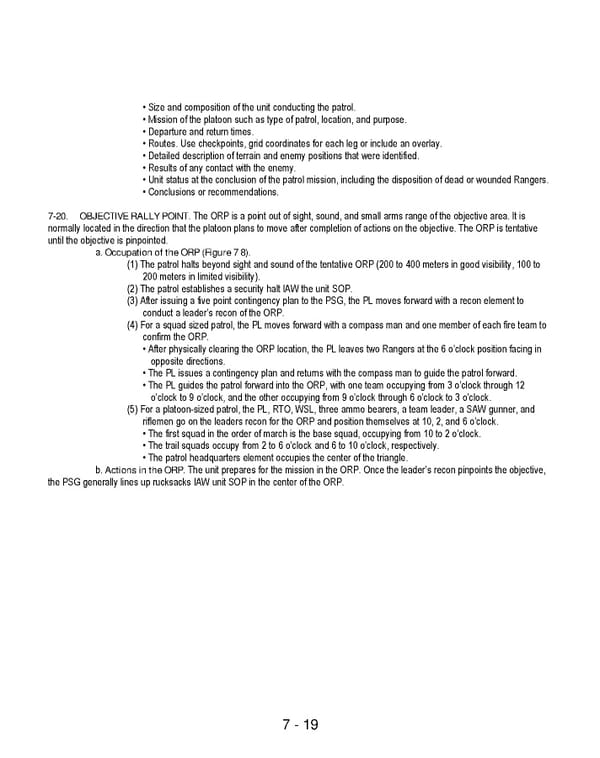7 - 19 • Size and composition of the unit conducting the patrol. • Mission of the platoon such as type of patrol, location, and purpose. • Departure and return times. • Routes. Use checkpoints, grid coordinates for each leg or include an overlay. • Detailed description of terrain and enemy positions that were identified. • Results of any contact with the enemy. • Unit status at the conclusion of the patrol mission, including the disposition of dead or wounded Rangers. • Conclusions or recommendations. 7-20. OBJECTIVE RALLY POINT. The ORP is a point out of sight, sound, and small arms range of the objective area. It is normally located in the direction that the platoon plans to move after completion of actions on the objective. The ORP is tentative until the objective is pinpointed. a. Occupation of the ORP (Figure 7 8). (1) The patrol halts beyond sight and sound of the tentative ORP (200 to 400 meters in good visibility, 100 to 200 meters in limited visibility). (2) The patrol establishes a security halt IAW the unit SOP. (3) After issuing a five point contingency plan to the PSG, the PL moves forward with a recon element to conduct a leader’s recon of the ORP. (4) For a squad sized patrol, the PL moves forward with a compass man and one member of each fire team to confirm the ORP. • After physically clearing the ORP location, the PL leaves two Rangers at the 6 o’clock position facing in opposite directions. • The PL issues a contingency plan and returns with the compass man to guide the patrol forward. • The PL guides the patrol forward into the ORP, with one team occupying from 3 o’clock through 12 o’clock to 9 o’clock, and the other occupying from 9 o’clock through 6 o’clock to 3 o’clock. (5) For a platoon-sized patrol, the PL, RTO, WSL, three ammo bearers, a team leader, a SAW gunner, and riflemen go on the leaders recon for the ORP and position themselves at 10, 2, and 6 o’clock. • The first squad in the order of march is the base squad, occupying from 10 to 2 o’clock. • The trail squads occupy from 2 to 6 o’clock and 6 to 10 o’clock, respectively. • The patrol headquarters element occupies the center of the triangle. b. Actions in the ORP. The unit prepares for the mission in the ORP. Once the leader’s recon pinpoints the objective, the PSG generally lines up rucksacks IAW unit SOP in the center of the ORP.
 Ranger Handbook Page 130 Page 132
Ranger Handbook Page 130 Page 132